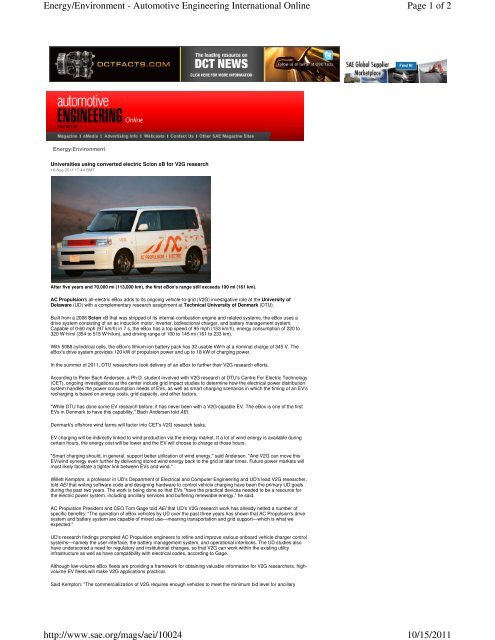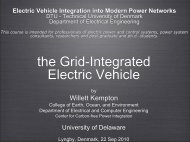Universities using converted electric Scion xB - Nuvve
Universities using converted electric Scion xB - Nuvve
Universities using converted electric Scion xB - Nuvve
You also want an ePaper? Increase the reach of your titles
YUMPU automatically turns print PDFs into web optimized ePapers that Google loves.
Energy/Environment - Automotive Engineering International Online<br />
Energy/Environment<br />
<strong>Universities</strong> <strong>using</strong> <strong>converted</strong> <strong>electric</strong> <strong>Scion</strong> <strong>xB</strong> for V2G research<br />
10-Aug-2011 17:44 GMT<br />
After five years and 70,000 mi (113,000 km), the first eBox's range still exceeds 100 mi (161 km).<br />
AC Propulsion's all-<strong>electric</strong> eBox adds to its ongoing vehicle-to-grid (V2G) investigative role at the University of<br />
Delaware (UD) with a complementary research assignment at Technical University of Denmark (DTU).<br />
Built from a 2006 <strong>Scion</strong> <strong>xB</strong> that was stripped of its internal-combustion engine and related systems, the eBox uses a<br />
drive system consisting of an ac induction motor, inverter, bidirectional charger, and battery management system.<br />
Capable of 0-60 mph (97 km/h) in 7 s, the eBox has a top speed of 95 mph (153 km/h), energy consumption of 220 to<br />
320 W·h/mi (354 to 515 W·h/km), and driving range of 100 to 145 mi (161 to 233 km).<br />
With 5088 cylindrical cells, the eBox's lithium-ion battery pack has 32 usable kW·h at a nominal charge of 345 V. The<br />
eBox's drive system provides 120 kW of propulsion power and up to 18 kW of charging power.<br />
In the summer of 2011, DTU researchers took delivery of an eBox to further their V2G research efforts.<br />
According to Peter Bach Andersen, a Ph.D. student involved with V2G research at DTU's Centre For Electric Technology<br />
(CET), ongoing investigations at the center include grid impact studies to determine how the <strong>electric</strong>al power distribution<br />
system handles the power consumption needs of EVs, as well as smart charging scenarios in which the timing of an EV's<br />
recharging is based on energy costs, grid capacity, and other factors.<br />
"While DTU has done some EV research before, it has never been with a V2G-capable EV. The eBox is one of the first<br />
EVs in Denmark to have this capability," Bach Andersen told AEI.<br />
Denmark's offshore wind farms will factor into CET's V2G research tasks.<br />
EV charging will be indirectly linked to wind production via the energy market. If a lot of wind energy is available during<br />
certain hours, the energy cost will be lower and the EV will choose to charge at those hours.<br />
"Smart charging should, in general, support better utilization of wind energy," said Andersen. "And V2G can move this<br />
EV/wind synergy even further by delivering stored wind energy back to the grid at later times. Future power markets will<br />
most likely facilitate a tighter link between EVs and wind."<br />
Willett Kempton, a professor in UD's Department of Electrical and Computer Engineering and UD's lead V2G researcher,<br />
told AEI that writing software code and designing hardware to control vehicle charging have been the primary UD goals<br />
during the past two years. The work is being done so that EVs "have the practical devices needed to be a resource for<br />
the <strong>electric</strong> power system, including ancillary services and buffering renewable energy," he said.<br />
AC Propulsion President and CEO Tom Gage told AEI that UD's V2G research work has already netted a number of<br />
specific benefits: "The operation of eBox vehicles by UD over the past three years has shown that AC Propulsion's drive<br />
system and battery system are capable of mixed use—meaning transportation and grid support—which is what we<br />
expected."<br />
UD's research findings prompted AC Propulsion engineers to refine and improve various onboard vehicle charger control<br />
systems—namely the user interface, the battery management system, and operational interlocks. The UD studies also<br />
have underscored a need for regulatory and institutional changes, so that V2G can work within the existing utility<br />
infrastructure as well as have compatibility with <strong>electric</strong>al codes, according to Gage.<br />
Although low-volume eBox fleets are providing a framework for obtaining valuable information for V2G researchers, highvolume<br />
EV fleets will make V2G applications practical.<br />
Said Kempton: "The commercialization of V2G requires enough vehicles to meet the minimum bid level for ancillary<br />
http://www.sae.org/mags/aei/10024<br />
Page 1 of 2<br />
10/15/2011
Energy/Environment - Automotive Engineering International Online<br />
services markets, such as the ability to produce power when there is a failure of generation or transmission elsewhere on<br />
the grid. Across grid areas, the minimum bid level ranges from 300 kW to 1 MW. With the eBox, about 100 of those<br />
vehicles would be required for a reliable 1 MW ancillary service commitment—30 would be required for 300 kW. Vehicles<br />
with smaller power capability than the eBox would require proportionally more vehicles to make the minimum."<br />
Rate Article Avg Rating<br />
Share:<br />
Contact Editor | E-mail | Print<br />
More on Energy/Environment<br />
� Delphi highlights light-duty diesel SCR dosing system<br />
and other technologies at Frankfurt Motor Show<br />
� Hydraulic hybrid transit bus from Altair doubles fuel<br />
efficiency of diesel buses<br />
� Company boasts highest-purity lithium at new plant<br />
� Chroma's new 'green' battery test sytem<br />
� New filter technology raises LPI system efficiency<br />
©2011 SAE International. All rights reserved.<br />
http://www.sae.org/mags/aei/10024<br />
5.0 (3 votes)<br />
Kami Buchholz<br />
Page 2 of 2<br />
10/15/2011



